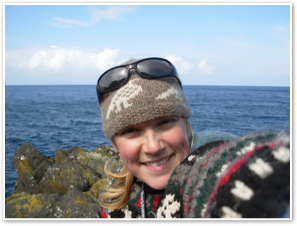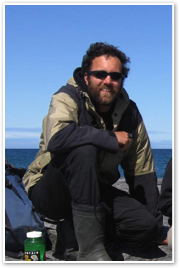Student Research
Dave Fifield: Canadian Wildlife Service; M.Sc. Student

A native Newfoundlander, I received a B.Sc. in Computer Science from Memorial University of Newfoundland in 1987 and worked as a programmer and support technician for the university for seven years. In 1990, I became interested in birds and in subsequent years contributed to a variety of seabird research projects. I entered the M.Sc. program in Cognitive and Behavioral Ecology at Memorial in September 2004 under the supervision of Dr. Bill Montevecchi and Dr. Greg Robertson.
Our research focuses on winter ecology of seabirds; the effect of colony and demographic variables on patterns and timing of winter movement, resource usage and geographical association. Although much is known about breeding season ecology of seabirds, we know relatively little about interactions with their environment during winter. Our investigations include the use of light-based geolocation loggers, stable isotope analysis and banding returns at Northern Gannet colonies on Bonaventure Island, PQ, Funk Island, NL and at Cape St. Mary's, NL. I am particularly interested in quantitative analysis and the efficient design of databases for ecological research.
Paul Regular: Ph.D. Student

I grew up in the town of Hampden, Newfoundland, where my fascination with Newfoundland wildlife began. I spent much of my time outside observing local birds, fish and mammals, educating myself about their behaviour and interactions. Knowing that I wanted to work with wildlife, I moved to St. John’s and completed my BSc (Honours) degree in Biology at Memorial University of Newfoundland (MUN; 2002-2006).
During my undergraduate, my interest quickly focused to seabirds after conducting my Honours research on auklet colonial behaviour under the supervision of Dr. Ian Jones on Buldir Island, Aleutian Islands, Alaska. After completing my B.Sc., I was hired by the Nature Conservancy of Canada (NCC) and Environment Canada (EC) to work on a research project dealing with common murre population and breeding trends at Cape St. Mary’s, Newfoundland. Dr. William Montevecchi and Dr. Gregory Robertson were my supervisors for much of this work, so it was a natural move after finishing my contract with NCC and EC to enter the PhD programme in Cognitive and Behavioural Ecology at MUN with Dr. Montevecchi and Dr. Robertson as my supervisors (2007).
The nature of this program and the research focus of my supervisors allow me to nurture my interest in seabird behavior and ecology. Our research focuses on the foraging ecology of breeding Common Murres. I am specifically interested in contrasting the foraging strategies of Common Murres breeding at a large offshore colony (Funk Island, Funk Island Ecological Reserve) and a small inshore colony (Gull Island, Witless Bay Ecological Reserve). Oceanographic conditions and prey distributions at these colonies are drastically different. Consequently foraging tactics and food web dynamics may differ greatly at these two sites. We will compare the foraging tactics of Common Murres from both islands using bird-born activity recorders, colony based and vessel based observations. In the process of doing this exciting data heavy research, I have developed a keen interest in statistical analyses, and somewhere between making posters and power points, I have grown increasingly fond of graphic design.



Laura McFarlane Tranquilla: Ph.D. Student

My research interests in avian ecology started while doing my BSc. at the University of New Brunswick, where I spent my summers studying songbird territory size in the blackfly-infested forests of New Brunswick. During this time, I was lucky enough to spend some time on Kent and Machias Seal Islands, where I was immediately captivated by the idea of working on seabirds. Since then, I have happily weathered remote fieldwork on rocky coastlines and stormy seabird islands, on both east and west coasts of Canada, catching and observing seabirds, sticking my arms into seabird burrows (up to the armpits in dirt) and have been chomped, scratched, and regurgitated upon by puffins, razorbills, murres, murrelets, auklets, and petrels.
Fieldwork aside, my research interests are broadly centered on seabird ecology, physiology, and conservation. During my MSc. at the Center for Wildlife Ecology at Simon Fraser University, I studied breeding timing, egg production, and stress responses of Marbled Murrelets. Since finishing my masters, I have worked in association with the Canadian Wildlife Service managing seabird databases, and writing and editing scientific papers, technical reports, and handbooks discussing the ecology and biology of marine birds.
I am delighted to be starting PhD studies in the Montevecchi lab at MUN in association with the IPY project. My research will focus on winter movement ecology of Thick-billed and Common Murres using data collected from tracking devices. I also plan to integrate winter movement ecology with trophic level associations and murre body condition.
Joseph Allen: Ph.D. Student

I began my Ph.D. at the University of Manitoba in 2008 under the supervision of Dr. Gail Davoren. My research interests are broad, ranging from behavioral and evolutionary ecology to conservation biology. Specifically, I am conducting vessel-based research on seabirds foraging socially at "Biological Hotspots" around Funk Island, Newfoundland, and Coats Island, Nunavut. My primary focal species are both murre species in the genus Uria; however, at many Hotspots birds are foraging in the presence of many other seabirds and marine mammals. I am utilizing both hydroacoustics and remotely-operated vehicles (ROV), in conjunction with ship-based observations, to social foraging dynamics of seabirds at sea.
Previously, I completed my MS in Environmental and Conservation Science at North Dakota State University under the supervision of Dr. Gary Nuechterlein. I examined the role of weather and habitat on reproduction in colonial nesting western grebes (Aechmophorus occidentalis) in western Minnesota. As part of this project, I also collaborated with many other students and agencies to examine the impact of an ecosystem biomanipulation and its effects on both biotic and abiotic components of the watershed. I also have a BS in wildlife biology from Ball State University.
Jennifer Provencher: M.Sc. Student

Growing up in Ontario, I always wanted to study marine life. After finishing high school, I moved to BC to complete my BSc in marine biology, where I got my first taste for marine science and spending time climbing around beaches and remote islands. After working on several marine mammal and coastal ecology projects in Baja California, southern British Columbia and Southeast Alaska, I became interested in seabirds while living in Bamfield BC, on the west coast of Vancouver Island.
I am interested in how seabird diet can be used as samplers of the marine environment. We have collected adult thick-billed murres from low, mid and high Arctic sites to examine their stomach contents to study what the birds are eating. I am comparing this to similar studies done in the 1970s and 80s in the same areas to assess how the diet of these seabirds has changed over the last several decades with reference to changing climatic conditions. I am also pairing the traditional dietary analysis of stomach contents with newer biochemical analysis such as stable isotopes and fatty acid signatures. By examining seabird diet in different ways, I hope to gain a better understanding of how these birds feed in the marine environment.
For this project, I spend my summer months on one of the TBMU colonies in the Eastern Canadian Arctic. During the winter, I spend most of my time sifting through the stomach contents of the birds collected, including: fish bones, otoliths, zooplankton, annelid jaws, squid beaks and other not so natural items like plastic and bird shot. I enjoy my time in the field and the lab immensely, as I get to study several levels of the marine environment, from observing cliff nesting seabirds in the Arctic, to keying out small amphipods from stomach contents. A great project to study marine life.

Paul Smith: Postdoctoral Researcher

I was bitten by the northern bug as an undergraduate student, and have travelled north every summer since. I am interested arctic ecology in general, and have experience with a variety of research topics from the morphology of muskoxen to the distribution of arctic cod in the Laptev Sea, Russia. However, my primary research interests are the breeding ecology and demography of arctic birds.
I received a BSc in biology and environmental science from Trent University, and an M.Sc. in zoology from the University of British Columbia. My Ph.D research at Environment Canada's National Wildlife Research Centre was an analysis of the causes and consequences of variability in shorebird reproductive success.
As a post-doctoral researcher with the IPY project, my goal is to synthesise the results of individual projects and develop an overall picture of how seabirds are responding to the changing conditions in the arctic. By better understanding the changes that have taken place already, we increase our capacity for predicting changes to come; this is the ultimate goal of the IPY project, and the goal to which I hope to contribute.

